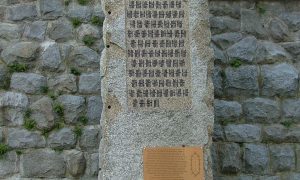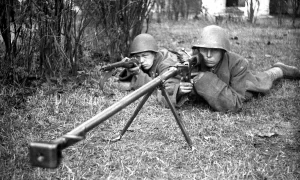Operation Spark
 Operation Iskra (German Zweite Ladoga-Schlacht – Second Battle of Lake Ladoga) – an offensive operation of the Soviet troops during the Great Patriotic War, carried out from January 12 to 30, 1943 by the forces of the Leningrad and Volkhov fronts with the assistance of part of the forces of the Baltic Fleet, Ladoga military flotilla and long-range aviation in order to break through the blockade of Leningrad.
Operation Iskra (German Zweite Ladoga-Schlacht – Second Battle of Lake Ladoga) – an offensive operation of the Soviet troops during the Great Patriotic War, carried out from January 12 to 30, 1943 by the forces of the Leningrad and Volkhov fronts with the assistance of part of the forces of the Baltic Fleet, Ladoga military flotilla and long-range aviation in order to break through the blockade of Leningrad.
On January 18, 1943, the blockade of Leningrad was broken. According to the original plan, the Soviet troops, units of the Volkhov (commander General I. Fedyuninsky ) and Leningrad (commander General L. Govorov ) fronts continued the offensive in order to defeat the Mginsk-Sinyavino grouping of the enemy and ensure a reliable railway connection between Leningrad and the country, but in fierce battles in February April failed to build on the success achieved in January. The Sinyavino heights, captured by the enemy in the autumn of 1941 – in the spring of 1942, were recaptured only by the 20th of January 1943. The Pulkovo heights passed to the forces of the Red Army in February 1943, the suburbs – by the beginning of spring.
The plan of the offensive near Leningrad in the winter of 1942-1943
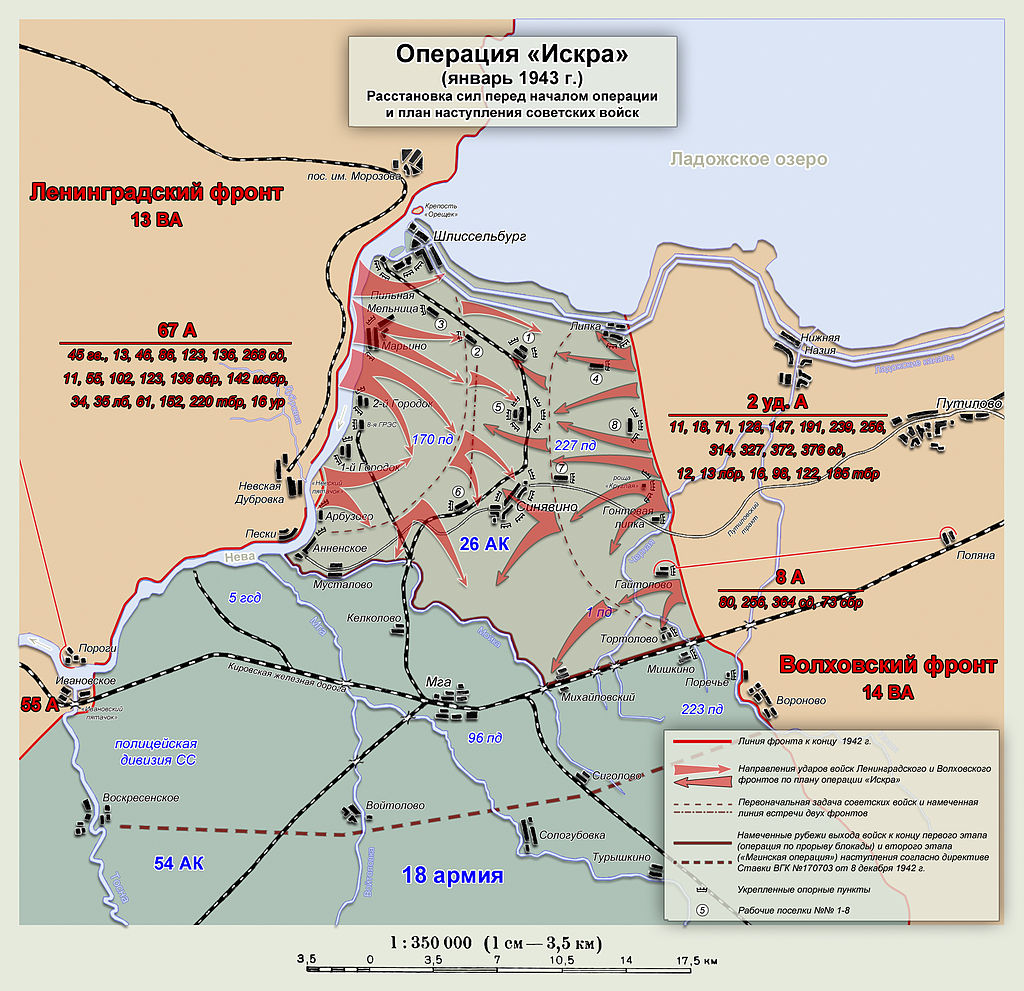 By the end of 1942, the situation near Leningrad continued to be difficult: the troops of the Leningrad Front and the Baltic Fleet were isolated, there was no land connection between the city and the “Great Land”. During 1942, the Red Army made two attempts to unblock the city. However, both the Lyubanskaya and Sinyavinskaya offensives were unsuccessful. The area between the southern coast of Lake Ladoga and the village of Mga (the so-called “Shlisselburg-Sinyavino ledge”), where the distance between the Leningrad and Volkhov frontswas the shortest (12-16 km), was still occupied by units of the German 18th Army.
By the end of 1942, the situation near Leningrad continued to be difficult: the troops of the Leningrad Front and the Baltic Fleet were isolated, there was no land connection between the city and the “Great Land”. During 1942, the Red Army made two attempts to unblock the city. However, both the Lyubanskaya and Sinyavinskaya offensives were unsuccessful. The area between the southern coast of Lake Ladoga and the village of Mga (the so-called “Shlisselburg-Sinyavino ledge”), where the distance between the Leningrad and Volkhov frontswas the shortest (12-16 km), was still occupied by units of the German 18th Army.
On November 18, 1942, the command of the Leningrad Front submitted to the Supreme Commander-in-Chief their proposals for preparing a new offensive near Leningrad. During the “Schlisselburg operation” in December 1942, it was planned, together with the Volkhov Front, to “lift the blockade from Leningrad” and “ensure the construction of the railway along the Ladoga Canal ”, and during the “Uritskaya operation” in February 1943, to restore land communication with the Oranienbaum bridgehead.
After studying the proposed plan by the Headquarters of the Supreme High Command, it was decided to abandon the Uritsa operation, and the plan for the Schlisselburg operation was approved by directive No. 170696 of December 2, 1942. At the end of 1942, I. V. Stalin proposed the name of the operation – “Iskra”, explaining that all attempts to break the blockade ended in failure, and now a “flame” should ignite from this spark. The operation was assigned a readiness date of January 1, 1943.
The offensive plan was set out in more detail in Directive No. 170703 of the Headquarters of the Supreme Command of December 8. The troops of the Leningrad and Volkhov fronts were instructed to “destroy the enemy grouping in the area of Lipka, Gaitolovo, Moscow Dubrovka, Shlisselburg and, thus, break the siege of Leningrad” and by the end of January 1943, complete the operation and reach the line of the Moika-Mikhailovsky-Tortolovo river. In addition, the directive spoke about the preparation and conduct of the “Mginsk operation” in the first half of February with the aim of defeating “the enemy in the Mga region and clearing the Kirov railway with access to the Voronovo-Sigolovo-Voitolovo-Voskresenskoye line”.
Thus, even at the planning stage, the Soviet command conceived the operation to be carried out in two stages. If at the first stage of the offensive the task was to break through the blockade of Leningrad, then at the second stage of the operation in February it was supposed to defeat the enemy grouping in the Mga region and ensure a strong railway connection between Leningrad and the country.
Operation Preparation
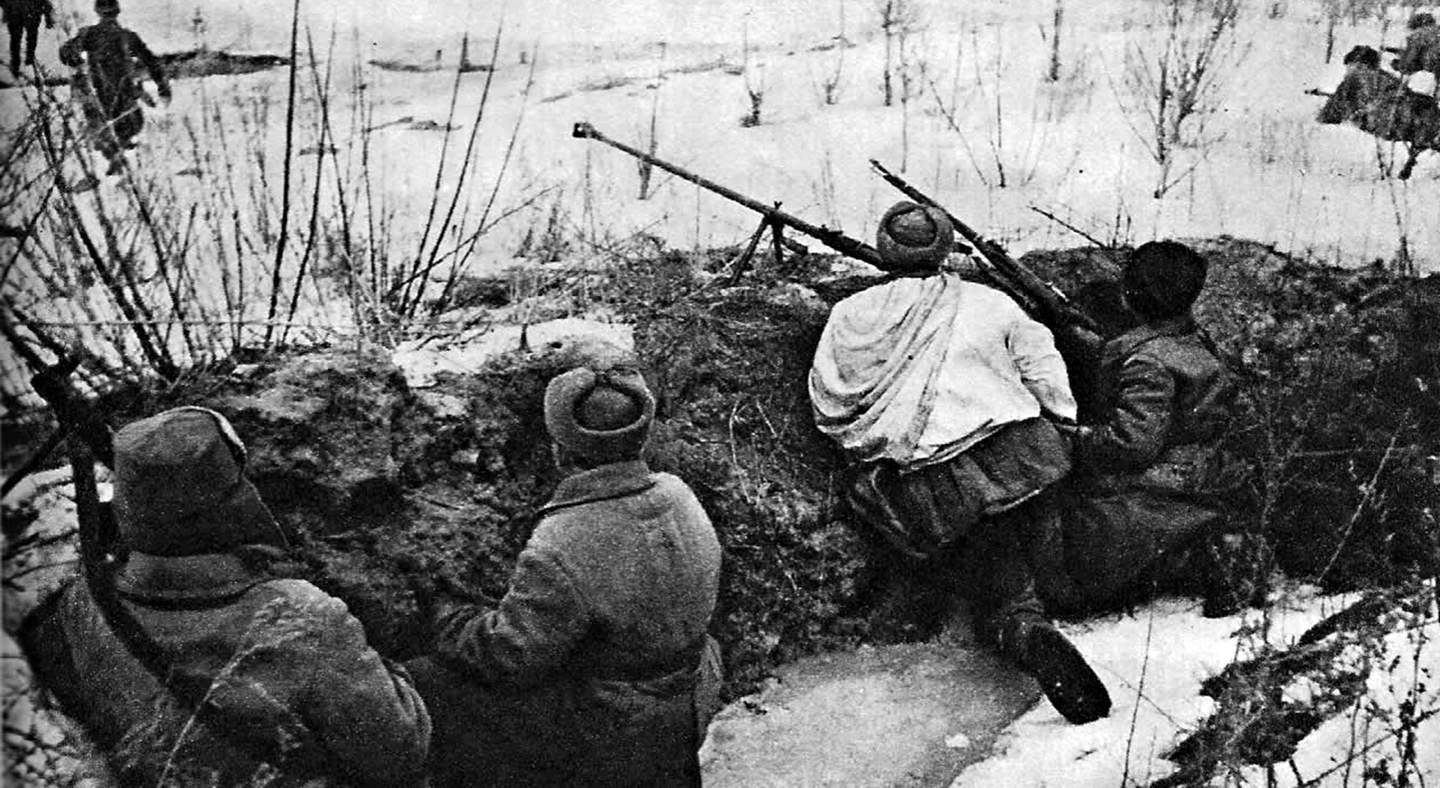 Almost a month was allotted for the preparation of the operation, during which the troops launched comprehensive preparations for the upcoming offensive.
Almost a month was allotted for the preparation of the operation, during which the troops launched comprehensive preparations for the upcoming offensive.
Particular attention was paid to the organization of interaction between strike groups. Why did the command and staffs of the two fronts coordinate their plans, establish lines of demarcation and work out interactions by conducting a series of military games based on the real situation. It was decided that if the troops of one of the fronts fail to reach the line planned for them, then the troops of the other do not stop advancing, but continue to move towards.
Since the Soviet troops had no experience in overcoming the enemy’s echeloned defense, a special place in the preparation was occupied by the training of formations in offensive operations in wooded and swampy areas and the assault on fortified enemy positions. Why in the rear created training fields and special towns. The commander of the Leningrad Front, L. A. Govorov, one by one, led units and units from the front line to the second echelon in order to conduct offensive training. In addition, the troops of the 67th Army worked out in the city limits the crossing of the Neva on ice and the establishment of crossings for heavy artillery and tanks.
The operation was difficult… The army troops had to, before contact with the enemy, overcome a wide water barrier, then break through the strong enemy positional defense, which was created and improved for about 16 months. In addition, we had to deliver a frontal strike, since maneuver was ruled out under the conditions of the situation. Considering all these circumstances, in preparing the operation, we paid much attention to training troops to skillfully and quickly force a wide water barrier in winter conditions and break through the enemy’s strong defenses.
– From the memoirs of the commander of the 67th Army M.P. Dukhanov.
The commander of the Leningrad Front developed methods and principles for the use of artillery in the forthcoming operation. By decision of L. A. Govorov, artillery groups were formed: long-range, special purpose, counter-mortar. Guards mortar units were brought into a separate group. By the beginning of the operation, thanks to the efforts of intelligence, the Soviet command had a fairly detailed idea of \u200b\u200bthe enemy defenses, while they managed to hide the direction of the main attack from the enemy.
At the end of December, due to a thaw, the ice on the Neva was not strong enough, and the swamps were difficult to pass, therefore, agreeing with the proposal of the commander of the Leningrad Front, the Headquarters of the Supreme High Command postponed the start of the operation to January 12, 1943.
In early January, the representative of the Headquarters of the Supreme High Command, K. E. Voroshilov, reported to I. V. Stalin that “by all indications, the enemy is not yet aware of the Iskra” and expressed confidence in the success of the operation. The State Defense Committee decided to send G.K. Zhukov to the Volkhov Front, “since K.E. Voroshilov was returning to Leningrad to coordinate the actions of the troops of the Leningrad Front”.
The number and tasks of the strike groups of the Soviet troops
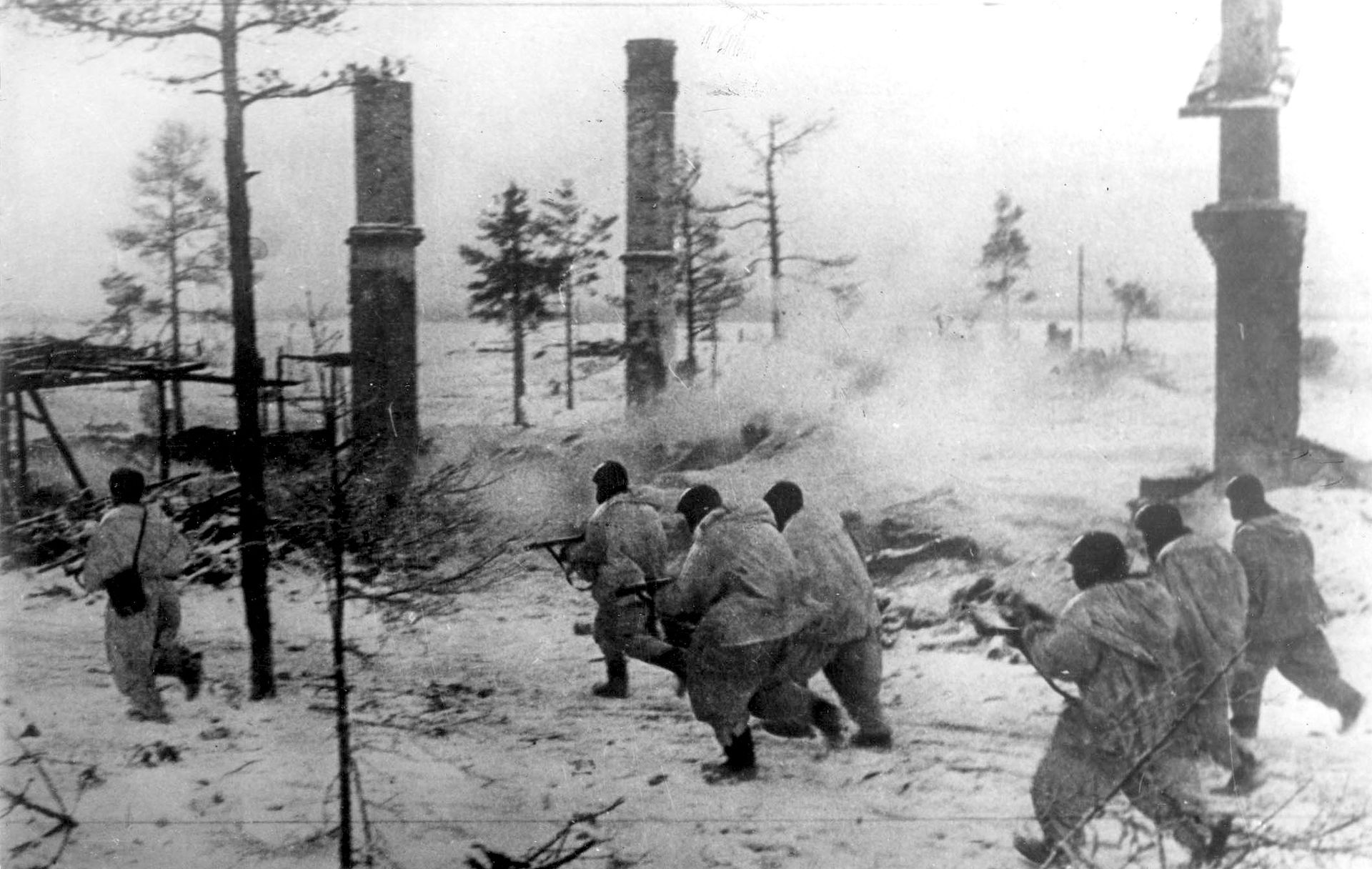 For the offensive, strike groups of the Leningrad and Volkhov fronts were formed, which were significantly reinforced with artillery, tank and engineering formations, including those from the reserve of the Headquarters of the Supreme High Command. The Leningrad Front received one rifle division, 4 rifle brigades, and an anti-aircraft artillery division, and the Volkhov Front received 5 rifle divisions, 3 rifle and ski brigades, and one engineer brigade.
For the offensive, strike groups of the Leningrad and Volkhov fronts were formed, which were significantly reinforced with artillery, tank and engineering formations, including those from the reserve of the Headquarters of the Supreme High Command. The Leningrad Front received one rifle division, 4 rifle brigades, and an anti-aircraft artillery division, and the Volkhov Front received 5 rifle divisions, 3 rifle and ski brigades, and one engineer brigade.
In total, the strike groups of the two fronts numbered 302,800 soldiers and officers, about 4,900 guns and mortars (caliber 76 mm and above), more than 600 tanks and 809 aircraft.
The Soviet troops had more than five times superiority over the enemy in terms of forces and means and were well provided materially for conducting long-term hostilities.
Grouping of the Leningrad Front
The basis of the strike force of the Leningrad Front was the 67th Army, built before the offensive in two echelons (4 rifle divisions in the first echelon and 2 in the second). To carry out the operation, each division was reinforced with a tank battalion, 4-5 artillery and mortar regiments, an anti-tank artillery regiment, and 1-2 engineer battalions.
The offensive was supported by the artillery of the army, the front and the Baltic Fleet – a total of about 1870 guns and mortars and the 13th Air Army with 414 aircraft.
The formations of the 67th Army were to cross the Neva on the 12-kilometer section between Nevsky Piglet and Shlisselburg, break through the enemy defenses and, delivering the main blow in the direction of Sinyavino, capture Arbuzov, Workers’ settlements No. 6 and No. 1, Sinyavino and Shlisselburg. And after connecting with the troops of the Volkhov Front – to develop an offensive to the southeast and reach the line on the Moika River.
Grouping of the Volkhov Front
The strike force of the Volkhov Front consisted of the 2nd shock army (6 rifle divisions in the first echelon, 4 in the second and 2 in reserve), part of the forces of the 8th army (2 rifle divisions and a marine brigade). The reinforcement forces for each division were allocated approximately the same as on the Leningrad front.
On the left flank of the offensive, part of the forces of the 8th Army operated: the 80th, 364th rifle divisions, the 73rd marine infantry brigade.
The offensive was supported by artillery of the front and two armies with about 2885 guns and mortars and the 14th Air Army with 395 aircraft.
The formations of the 2nd shock army were to break through the enemy defenses on the 12-kilometer section of the Lipki-Gaitolovo front, capture the centers of resistance Lipka, Rabochesky settlement No. 8, the Kruglaya grove and Gaitolovo, and then, moving westward and towards Sinyavino, capture Working settlements No. 1, 5, 7 and Sinyavino. After connecting with the troops of the Leningrad Front on the line Workers’ settlement No. 2 – Workers’ settlement No. 6, develop the offensive in the direction to the south. Formations of the 8th Army were to break through the enemy defenses in the Gaitolovo-Mishkino sector and advance in the direction of Tortolovo-Mikhailovsky.
German defense in the area of the Shlisselburg-Sinyavino ledge
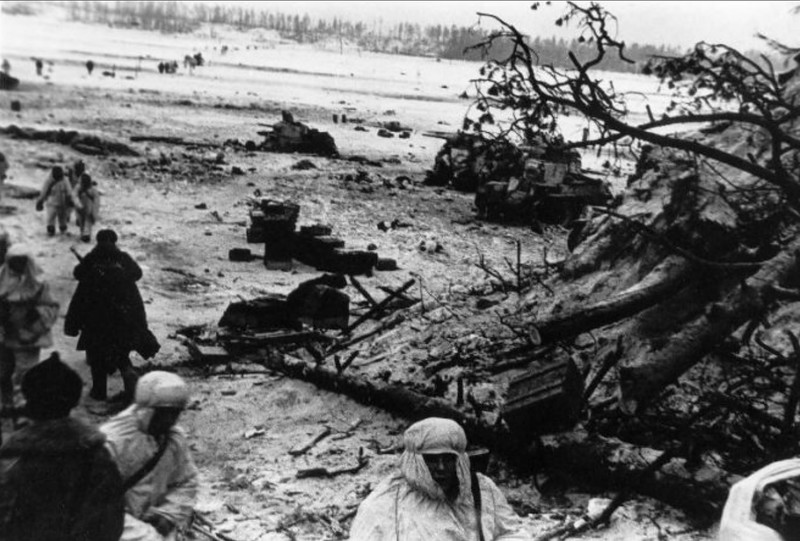 The defense of the Shlisselburg-Sinyavino ledge was carried out by the main forces of the 26th and part of the divisions of the 54th Army Corps of the 18th Army.
The defense of the Shlisselburg-Sinyavino ledge was carried out by the main forces of the 26th and part of the divisions of the 54th Army Corps of the 18th Army.
In view of the significant superiority of the Soviet army in manpower and equipment, the German command expected to hold positions, primarily due to the power of its defense: most of the villages were strongholds, the front line and positions in the depths of the defense were fenced with minefields, wire barriers and fortified with bunkers.
In the offensive zone of the 67th Army, the defense was held by the 328th regiment of the 227th infantry division, the 170th infantry division in full strength and the 100th regiment of the 5th mountain rifle division. On the first line, the main nodes of defense were the structures of the 8th State District Power Plant, the 1st and 2nd Gorodoks and the houses of the city of Shlisselburg. The second line of defense passed through the workers’ settlements No. 1 and No. 5, the stations Podgornaya, Sinyavino, the workers’ settlement No. 6, the village of Mikhailovsky.
In the offensive zone of the 2nd shock army and the right wing of the 8th army, the defense was held by the 227th infantry division (without one regiment), the 1st infantry division, the 374th regiment of the 207th security division and the 344th regiment of the 223rd th Infantry Division. The main centers of resistance were Lipka, Workers’ settlement No. 8, the Kruglaya grove, the villages of Gaitolovo and Tortolovo.
The number of the 26th Army Corps (commander – General of the Infantry Ernst von Leiser ) was approximately 60,000 soldiers and officers (1st, 170th, 223rd, 227th Infantry Divisions). The 96th Infantry Division, the main forces of the 5th Mountain Rifle Division, and the 502nd Heavy Tank Battalion were in reserve in the Mga area. On October 30, the battalion had 9 tanks Pz.Kpfw.VI “Tiger” and 18 PzKpfw III. Only in February 1943, the battalion received 6 more heavy tanks.
Thus, the defense of the Shlisselburg-Sinyavino ledge was carried out by approximately 6 calculated divisions with the support of 700 guns and mortars, as well as 27 tanks.
Air support for the 18th Army and the entire Army Group North was provided by the 1st Air Fleet. The enemy only near Leningrad had 250 aircraft, and the entire Army Group North had about 450 combat vehicles at its disposal.
The course of hostilities
Start of the attack. January 12
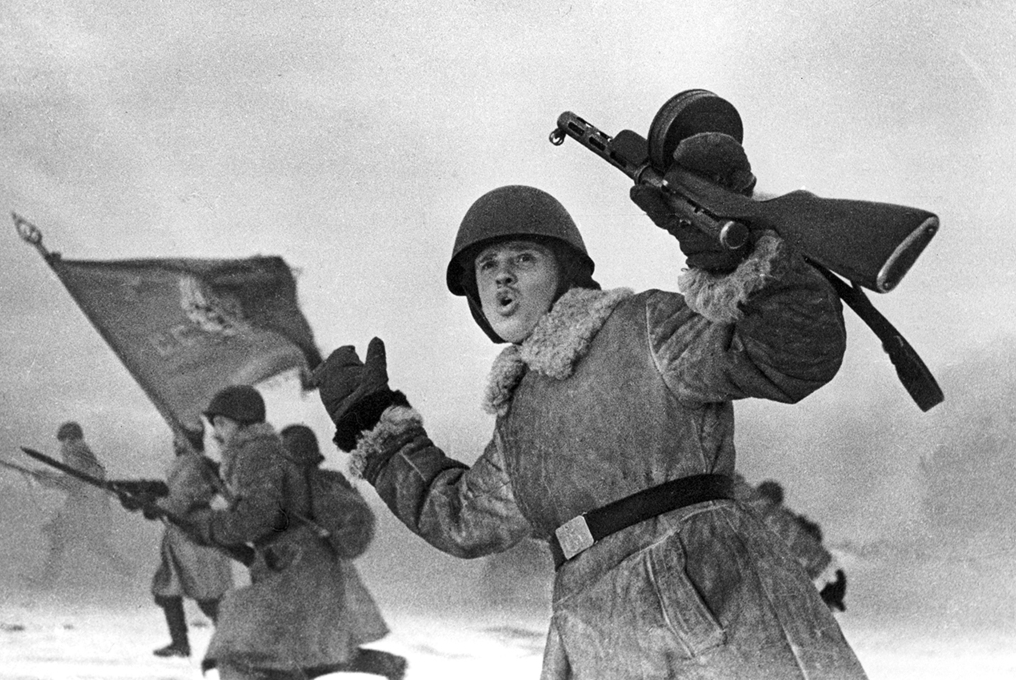 On the night of January 12, Soviet bombers launched a massive attack on enemy positions in the breakthrough zone, as well as on airfields and railway junctions in the rear.
On the night of January 12, Soviet bombers launched a massive attack on enemy positions in the breakthrough zone, as well as on airfields and railway junctions in the rear.
At 9:30 in the morning, at the same time, the artillery of both fronts began artillery preparation, which continued in the offensive zone of the 67th Army for 2 hours 20 minutes, and 1 hour 45 minutes in the offensive sector of the 2nd Shock Army.
At 11:50, under the cover of a “barrage of fire” and machine-gun fire from the 16th fortified area, the 4th division of the first echelon of the 67th Army began crossing the Neva. Each division was reinforced by four or five artillery and mortar regiments, an anti-tank artillery regiment, and one or two engineer battalions. The attack was also supported by 147 light tanks and armored vehicles, the weight of which could withstand the ice on the Neva.
On the first day, success was achieved in the central sector thanks to the artillery preparation of the 38th Guards Mortar Regiment and the subsequent offensive – by the 268th division and the 86th separate tank battalion in the area north of the 2nd Gorodok and the 136th division and the battalion of the 61st tank brigades in the Maryino area. By the end of the day, having broken the resistance of the enemy’s 170th infantry division, the Soviet troops managed to capture a bridgehead about 6 kilometers wide and up to 3 kilometers deep on the left bank of the Neva. Immediately after that, the engineering units began to build a crossing in the Maryino area for medium and heavy tanks, which was completed only by January 14.
On the flanks of the 67th Army, the offensive developed less successfully. The 45th Guards Rifle Division and the 118th Separate Tank Battalion operated on the right flank in the area of the Nevsky Piglet. One regiment of the division, which struck directly from the bridgehead, managed to advance only 500-600 meters and capture only the first enemy trench. The other two regiments of the division, while crossing the Neva near the 8th GRES, suffered heavy losses and did not achieve success, and the 118th separate tank battalion lost all vehicles by the end of the day on January 13. On the left flank of the general offensive in the Shlisselburg area, the 86th Infantry Divisionwas stopped by heavy enemy fire and failed to cross the Neva. The command decided not to continue the attacks in this area. The division was withdrawn to the starting line, and at the end of the day was transferred to the bridgehead captured by the 136th Infantry Division in the Maryino area, with the task of advancing on Shlisselburg from the south the next day.
At 11:15, the 2nd shock army went on the offensive, and at 11:30 – units of the 8th army. Since the artillery was not able to suppress all the firing points, and the peat bogs turned out to be difficult to pass even in winter, the offensive developed with great difficulty. On the right flank and in the central offensive sector, the 128th, 372nd, 256th rifle divisions managed to break through the defenses of the German 227th infantry division and move up to 2 kilometers forward, but they failed to take the strongholds of Lipka and Rabochesky settlement No. 8. On the left flank of the offensive, only the 327th Infantry Division achieved success, which managed to capture most of the stronghold in the Kruglaya grove. 376th Rifle Division in the area south of the Kruglaya Grove, as well as the 80th, 265th Rifle Divisions and the 73rd Marine Brigade of the 8th Armyhave not been successful. The defense of the units of the 1st German division was not broken and the offensive in this sector did not receive further development until the end of the operation.
Already on the first day of the Soviet offensive, the German command was forced to strengthen its defenses by introducing units of the 96th Infantry and 5th Mountain Divisions into battle, and then two regiments of the 61st Infantry Division (“Major General W. Huner ’s group ”).
Fights 13-17 January
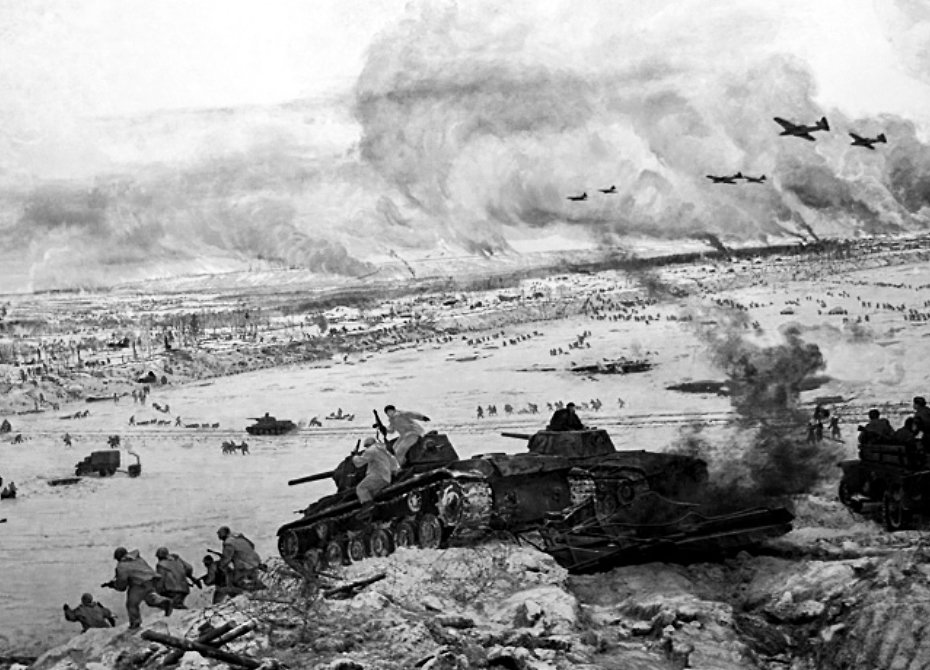 On January 13-17, the fighting took on a protracted and fierce character. The enemy offered stubborn resistance, relying on numerous defense units. For the final turning point in the course of the battle, the Soviet command, from the second day of the operation, began to bring into battle the second echelons of the armies.
On January 13-17, the fighting took on a protracted and fierce character. The enemy offered stubborn resistance, relying on numerous defense units. For the final turning point in the course of the battle, the Soviet command, from the second day of the operation, began to bring into battle the second echelons of the armies.
In the offensive zone of the 67th Army, the advance in the direction of Rabochey Settlement No. 5 of the 136th Infantry Division, which was given the main forces of the 61st Tank Brigade, was of decisive importance. In order to secure the flanks of the group advancing on Rabochesky Settlement No. 5, on January 13, the 123rd Rifle Brigade was brought into battle in the direction of Work Settlement No. 3, and on the following days, the 123rd Rifle Division and the 152nd Tank Brigade in the direction of Sinyavino and Workers’ settlement No. 6. After several days of fierce fighting, the 123rd brigade managed to take Workers’ settlement No. 3 and reach the outskirts of Workers’ settlements No. 1 and No. 2, and the 136th division went to Workers’ settlement No. 5, but they could not take it on the move could.
For several days, on the outskirts of Shlisselburg, fierce battles were fought by the 86th Infantry Division and the battalion of armored vehicles of the 61st Tank Brigade. The attack on the city was also supported by the 34th ski brigade on the right flank and the 55th rifle brigade, advancing on the ice of Lake Ladoga. By the evening of January 15, the Soviet units reached the outskirts of the city. The German garrison of Shlisselburg found itself in a critical situation, but continued to hold the city.
On January 14, 1943, a German tank of a type unknown to Soviet soldiers was knocked out in the area of Workers’ Settlement No. 5, which was towed to the location of Soviet troops on January 17. It turned out to be the latest German heavy tank Pz. kpfw. VI “Tiger” from the 502nd heavy tank battalion. A little later, another Tiger tank was captured. Both tanks were sent to the Kubinka training ground, where they were thoroughly examined. Soviet engineers, having identified the vulnerabilities of the tank, created a number of instructions and posters on the fight against these formidable combat vehicles, which helped the Soviet troops in subsequent battles.
On the right flank of the 67th Army, the offensive of the 45th Guards Division in the following days was again unsuccessful, even despite the introduction of the reserves of the 45th Guards Division itself and part of the forces of the 13th Infantry Division into battle. A difficult situation also developed in the offensive sector of the 268th Infantry Division, which bypassed the 8th State District Power Plant from the north and northeast. However, the Soviet artillery failed to destroy the enemy’s firing points in this strong point, as well as in the 1st, 2nd Gorodok, which fettered the offensive of both the 268th Rifle Division and the 45th Guards Division. In addition, the German troops, having received units of the 5th mountain rifle and 96th infantry divisions as reinforcements, constantly launched violent counterattacks, including with the support of the 502nd heavy tank battalion, in order to reach the flank of the Soviet units successfully advancing in the direction of Workers’ Village No. 5. For several days, the 268th Infantry Division had to fight heavy defensive battles and even leave a number of conquered positions. However, the enemy did not manage to reach the Neva. Having repulsed the German counterattacks, the Soviet troops continued their offensive, but by January 20, the 268th, 123rd rifle divisions, as well as the 102nd and 142nd rifle brigades, brought into battle from the reserve in this sector, only managed to block a powerful the enemy’s stronghold in the area of the 1st and 2nd Gorodoks and the 8th State District Power Plant, but not to capture it. Also, in a week of fierce fighting, the 45th Guards Rifle Division did not achieve any significant results.
In the offensive zone of the 2nd shock army the enemy, relying on strongholds in Lipka and Workers’ settlements No. 7 and No. 8, continued to resist fiercely. On January 13, despite the entry into battle of the 18th Infantry Division, the 98th Tank Brigade in the direction of Rabochey Settlement No. 5 and the 71st Infantry Division south of the Kruglaya grove, the formations of the 2nd Shock Army were unable to achieve significant advance on either one direction. In the following days, the command of the 2nd shock army continued to build up the strike force, mainly in the area from the Kruglaya grove to Gaitolov, bringing into battle the 11th, 191st, 239th rifle divisions, the 13th ski and 122nd tank brigade. However, attempts to expand the breakthrough front to the south ended almost to no avail. The only success in this direction was achieved by the 256th Rifle Division, which on January 14 managed to take the Podgornaya station,
The 12th Ski Brigade was sent to the Lipka area, which was still held by the enemy, in support of the 128th Infantry Division with the task of bypassing Lipka on the ice of Lake Ladoga and attacking the enemy from the rear.
In the center of the offensive of the 2nd shock army, on January 15, the 372nd division took Workers’ settlements No. 8 and No. 4, and on January 17 it went to Workers’ settlement No. 1. By this time, the 18th Rifle Division and the 98th Tank Brigade had already been several days fought a fierce battle on the outskirts of Rabochey Settlement No. 5, which was also attacked from the west by the 136th division and the 61st tank brigade of the 67th army.
Breaking the blockade of Leningrad. Fights January 18-20
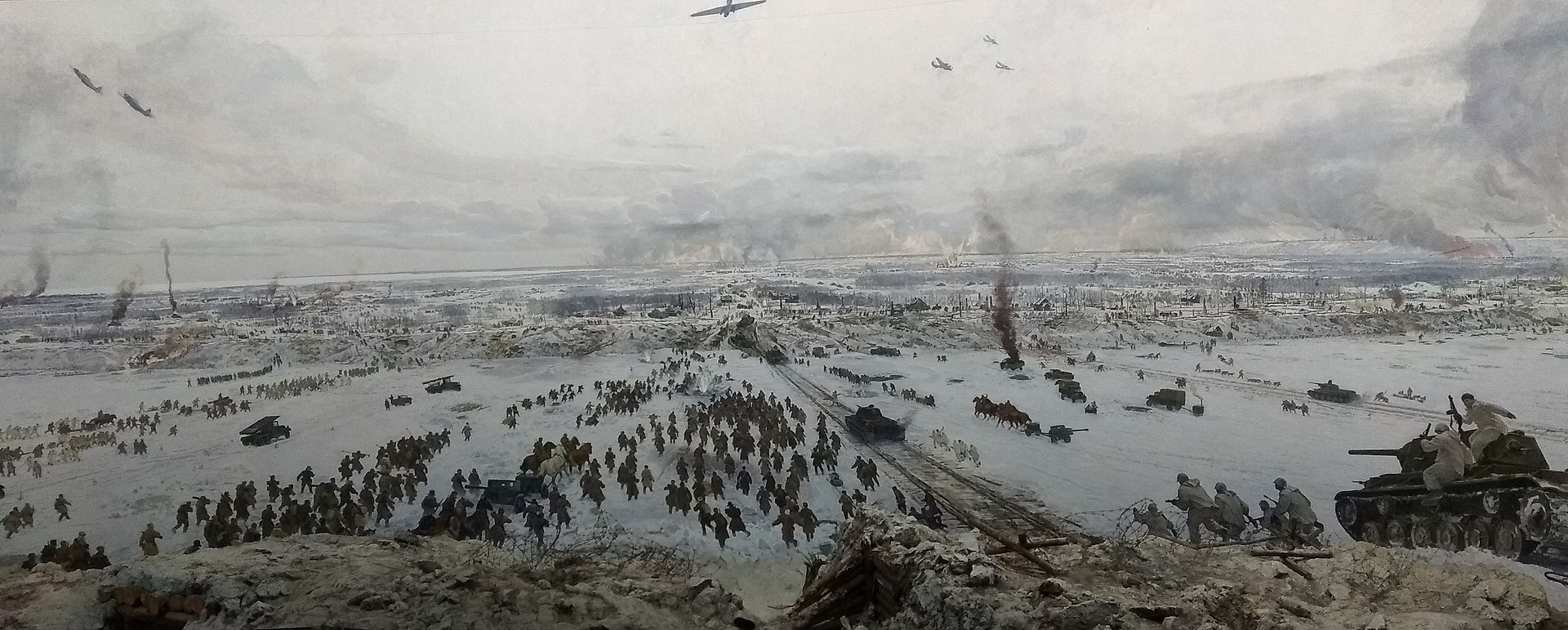 By January 18, the troops of the Leningrad and Volkhov fronts were separated by only a few kilometers. The German command, realizing the seriousness of the situation, allowed the units remaining in the encirclement in the Shlisselburg and Lipka areas to make their way south to Sinyavin, for which the “Hüner group” had to hold Workers’ settlements No. 1 and No. 5 until the last opportunity.
By January 18, the troops of the Leningrad and Volkhov fronts were separated by only a few kilometers. The German command, realizing the seriousness of the situation, allowed the units remaining in the encirclement in the Shlisselburg and Lipka areas to make their way south to Sinyavin, for which the “Hüner group” had to hold Workers’ settlements No. 1 and No. 5 until the last opportunity.
January 18, 1943, at 9:30 am, the 1st separate rifle battalion of the 123rd separate rifle brigade of the 67th army of the Leningrad Front, led by the deputy commander for political affairs, Major Melkonyan, senior lieutenant Kalugov, sergeant Anisimov, met with units of the 372nd division of the 2nd th shock army of the Volkhov Front, led by Major Melnikov and the commander of the 440th reconnaissance company, Senior Lieutenant Ishimov, on the eastern outskirts of Workers’ Village No. 1. At 10:30 they were joined by the commander of the 372nd Infantry Division, Colonel Radygin, who took on further command.
On January 18, German troops launched a counterattack from the area of Workers’ Village No. 5 against the 136th Infantry Division to ensure a breakthrough of their encircled units. The attack was repulsed and the 136th Rifle Division, pursuing the enemy, broke into Rabochesky Settlement No. 5, where, before 12:00 pm, a group of senior lieutenant Bryteshko, Sergeant Tregub and Red Army soldier Trunov met with the first rifle battalion under the command of Lieutenant (later Major ) Noskova A. V. 424th Infantry Regiment of the 18th Infantry Division of the 2nd Shock Army. A little later on the same day, formations of the 86th Infantry Division and a battalion of armored vehicles of the 61st Tank Brigade completely cleared Shlisselburg from the enemy, and at the end of the day, the advanced units of the 34th Ski Brigade established contact with the 128th Rifle Division and the 12th Ski Brigade of the 2nd Shock Army, which finally took Lipki.
Thus, on January 18, 1943, the blockade of Leningrad was broken.
However, the common front of the 67th and 2nd shock armies was not yet dense enough and a significant part of the encircled German group (about 8,000 people), having dispersed and abandoned heavy weapons, broke through Workers’ settlement No. 5 to the south and by January 20 left the encirclement in the Sinyavino area. Retreating, the German troops took up a pre-prepared position on the line of the 1st and 2nd towns – Workers’ settlement No. 6 – Sinyavino – the western part of the Kruglaya grove, where the SS police division, the 5th mountain rifle and the 1st infantry divisions were already entrenched. Soon, the command of the 18th Army additionally deployed units of the 28th Jaeger, 11th, 21st and 212th Infantry Divisions to this area.
Continuation of the attack. January 20-30
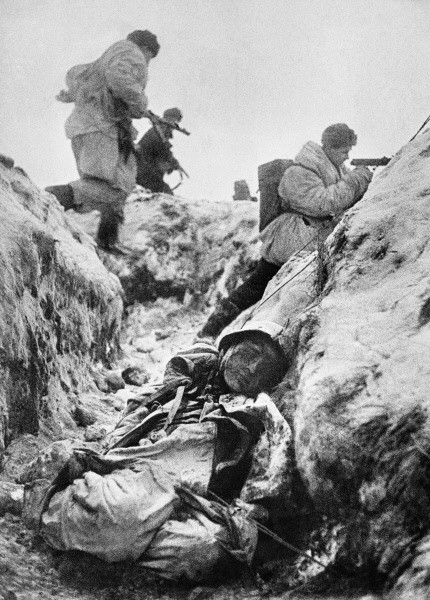 Having formed a common front and entrenched themselves on new lines, the troops of the 67th and 2nd shock armies began to prepare for the continuation of the offensive on the sector of the front from the Neva to Gontovaya Lipka in the direction of Mustolovo – Sinyavino – Mikhailovsky.
Having formed a common front and entrenched themselves on new lines, the troops of the 67th and 2nd shock armies began to prepare for the continuation of the offensive on the sector of the front from the Neva to Gontovaya Lipka in the direction of Mustolovo – Sinyavino – Mikhailovsky.
On January 20, G. K. Zhukov reported to I. V. Stalin the plan of the operation “to capture the Kirov railway” (“Mginsk operation”), which was prepared after a meeting with L. A. Govorov, K. A. Meretskov and K. E Voroshilov. It was planned that on January 20, the 67th and 2nd shock armies would begin a general offensive to the south and, having “finished with the enemy in the Sinyavino area” and reached the Mga River, on January 26, they would begin the second stage of the operation.
However, it was hard to count on success in the current situation. The enemy firmly occupied the new defensive line with forces of up to 9 divisions. In addition, the German grouping was significantly reinforced with artillery and aircraft. On January 20, after artillery preparation, the 67th Army went on the offensive. The 46th Rifle Division, the 138th Rifle and 152nd Tank Brigades attacked southeast of the 1st and 2nd Gorodoks with the task of capturing Mustalovo and bypassing Sinyavino from the west. The 142nd Marine Brigade and the 123rd Rifle Brigade were advancing on Sinyavino, while the 220th Tank and 102nd Rifle Brigades and the 123rd Rifle Division were advancing with the task of capturing the enemy’s resistance center in the area of the 1st and 2nd Gorodoks and reaching Arbuzovo. Almost all attacks ended in vain – they only managed to advance towards Sinyavino by 2 kilometers and cut the railway southeast of the 1st Gorodok.
Despite the failure, the commander of the Leningrad Front decided to continue the offensive, for which the 67th Army was transferred from the front reserve 4 rifle divisions, 2 rifle and 1 tank brigades. On January 25, the 11th and 55th rifle brigades went on the offensive with the aim of breaking through the enemy’s defenses in the area of Workers’ Settlement No. 6. The mobile group (220th tank and 34th ski brigades), which was to capture Mustalovo and cut off the withdrawal routes of the German group in the area of the 1st and 2nd Gorodoks. However, it was not possible to break through the enemy defenses. Fierce fighting continued until the end of January, but despite the introduction of new units into battle, the 67th Army failed to develop the offensive.
The 2nd shock army also failed to complete the task. Unable to maneuver, the Soviet troops advanced through the peat bogs, without proper support from artillery and tanks. By January 25, the joint efforts of the 147th and 239th rifle divisions and the 16th tank brigade managed to take Rabochey settlement No. 6. Until the end of January, formations of the 2nd shock army stormed the Sinyavinsky heights, part of the Krugly grove and the Kvadratnaya grove next to the Workers’ settlement No. 6. The latter was taken by units of the 80th Infantry Division on January 29. Developing the offensive, on January 31, the division managed to capture Sinyavino, but were driven out of there by a fierce counterattack of the enemy. In other directions, the formations of the army had no advance and occupied the former lines. By the end of January 1943, the troops of the 2nd shock army entered the line:.
The representative of the Headquarters of the Supreme High Command, K. E. Voroshilov, in his report to I. V. Stalin on January 27, stated: “without the capture of the Sinyavin positions, it is impossible to proceed with the implementation of your order to liberate the Neva and the Kirov railway”. Thus, it was obvious that the Soviet troops failed to develop the offensive in the southern direction immediately and the plan for the further offensive needed to be adjusted.
Adjustment of offensive plans
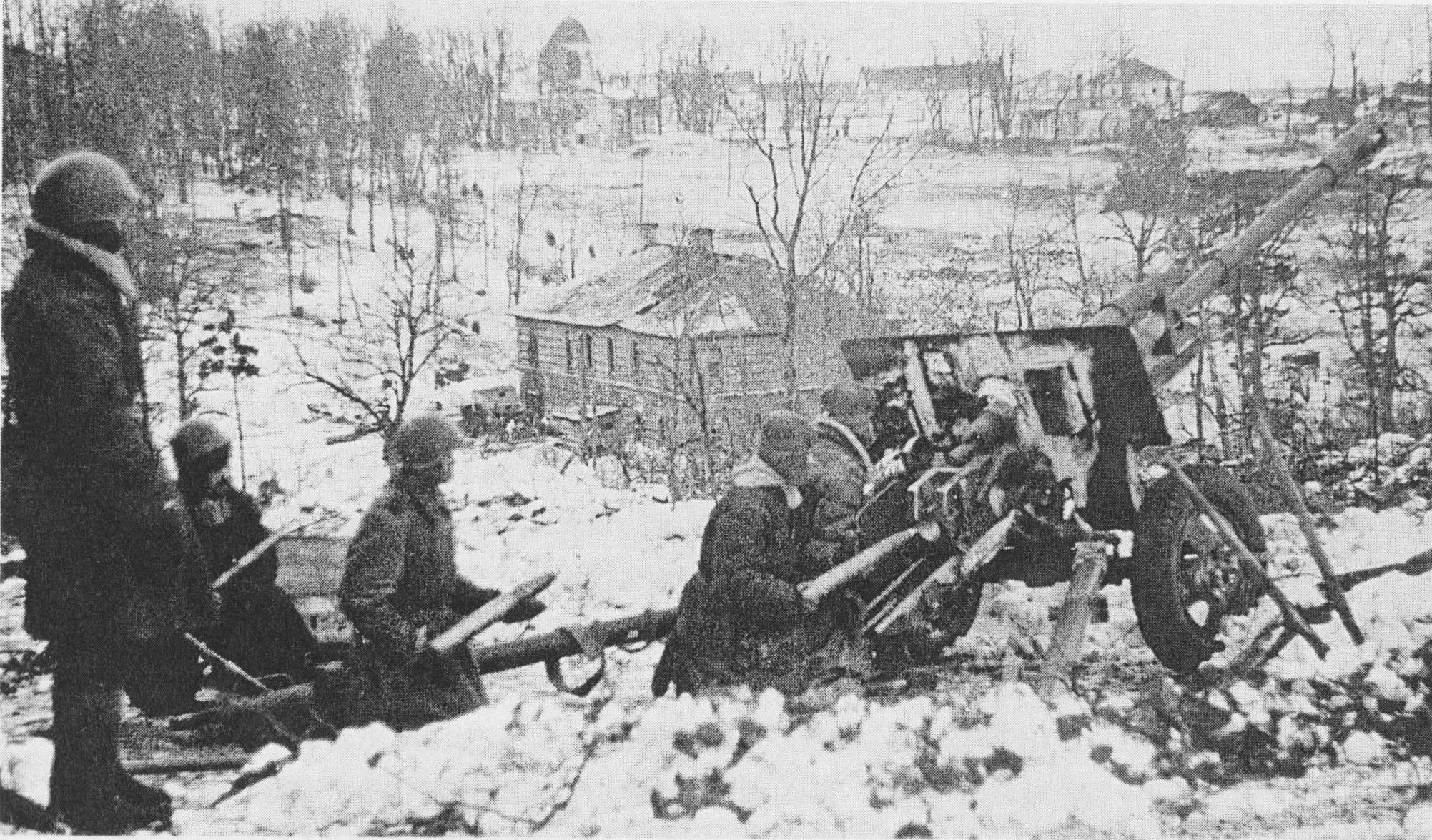 According to Directive No. 170703 of the Headquarters of the Supreme High Command of December 8, 1942, breaking the blockade was only the first stage of the offensive. Despite the fact that the military operations of the 67th and 2nd shock armies were not successful at the end of January, the Soviet command was not going to abandon the original plan, but was forced to adjust the plan for the next stage of the operation.
According to Directive No. 170703 of the Headquarters of the Supreme High Command of December 8, 1942, breaking the blockade was only the first stage of the offensive. Despite the fact that the military operations of the 67th and 2nd shock armies were not successful at the end of January, the Soviet command was not going to abandon the original plan, but was forced to adjust the plan for the next stage of the operation.
Based on the fact that “frontal strikes in the Sinyavino area have not yet yielded proper results,” the Headquarters of the Supreme Command, by its directive No. 30034 of February 1, ordered the troops of the Leningrad and Volkhov fronts to deliver “additional strikes from the flanks” in order to encircle the Mginsk-Sinyavino enemy grouping. At the same time, the troops of the 67th and 2nd shock armies were supposed, “without expecting these flank attacks, by covering the Sinyavino heights and the area of \u200b\u200bGorodki 1st and 2nd, continue to destroy the enemy and capture the Sinyavino area, Gorodok 1st and 2 th “.
According to the final offensive plan, starting from February 8, “flank attacks” were delivered by the 54th Army of the Volkhov Front from the Smerdyn region in the direction of Vaskina Niva – Shapka and the 55th Army of the Leningrad Front from the Ivanovskoye and Rozhdestveno regions in the directions of Mga and Tosno. In the end, the Soviet troops, having surrounded and destroyed the Mginsk-Sinyavin grouping of the enemy, were supposed to reach the line Ulyanovka – Tosno – Lyuban.
The offensive aimed at defeating the “Mginsk-Sinyavino-Shapkinskaya enemy grouping” was part of the general offensive in the North-West direction (Operation Polar Star) and was supposed to contribute to the success of the Soviet troops in the Demyansk offensive operation.
Despite the scale of the plans, very little time was allotted for the preparation of “flank strikes”. The command of the two fronts needed to quickly develop a detailed plan for the upcoming offensive, organize strike groups, carry out large regroupings of units between the armies, and provide the advancing units with ammunition, fuel, and food. Serious concerns were also raised by the continuation of the offensive of the 67th and 2nd shock armies, which had already suffered heavy losses. By the beginning of February, due to heavy losses in previous battles and the transfer of a number of units to other sectors of the front, the number of 67th and 2nd shock armies was greatly reduced: in total, both armies numbered about 150,000 soldiers and officers with support and support units. On the other hand, the Soviet command, not without reason, believed that the offensive in January forced the command of the German 18th Army to withdraw all reserves to the Mga region and weaken the flanks.
Continuation of Operation Iskra, February 10-27, 1943
The offensive of the 55th Army in the area of Krasny Bor
Main article: Krasnoborsk operation (1943)
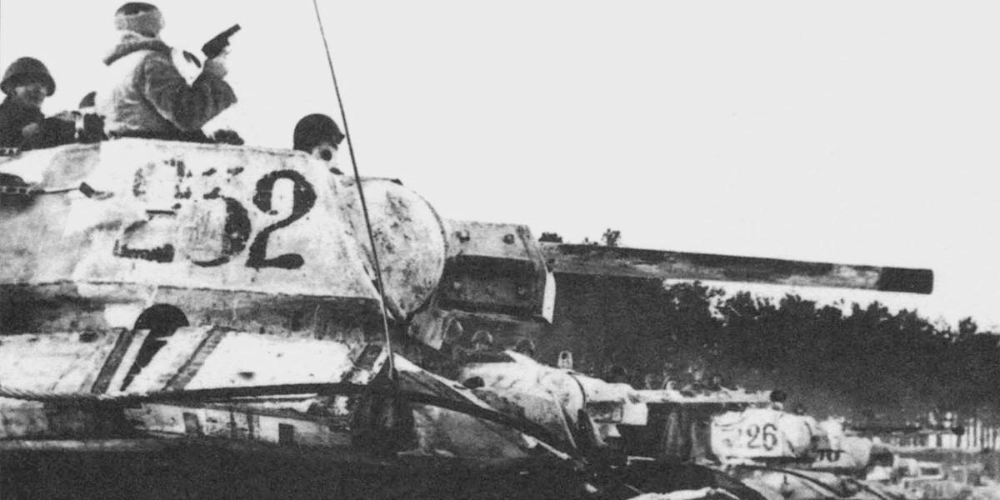 On February 10, 1943, after a two-hour artillery preparation, in which up to 1,000 guns and mortars took part, the strike force of the 55th Army launched an offensive from the Kolpino area in two directions – to Ulyanovsk and Mga. The remaining forces of the army, including a powerful tank grouping (152 tanks, self-propelled guns and an armored car) were to develop the offensive in case of initial success.
On February 10, 1943, after a two-hour artillery preparation, in which up to 1,000 guns and mortars took part, the strike force of the 55th Army launched an offensive from the Kolpino area in two directions – to Ulyanovsk and Mga. The remaining forces of the army, including a powerful tank grouping (152 tanks, self-propelled guns and an armored car) were to develop the offensive in case of initial success.
In two days of fighting, units of the army liberated Krasny Bor, Popovka station, Staraya Myza, Mishkino and managed to move forward up to 5 kilometers. However, units of the 250th Spanish division and the SS police division opposing the Soviet troops on this sector of the front managed to hold out until reinforcements arrived and the offensive of the 55th army was stopped.
By February 27, units of the army advanced only 4-5 kilometers on a front section 14-15 kilometers wide and did not complete the main task.
The offensive of the 54th army in the area of Smerdyn
On February 10, formations of the 54th Army (10 rifle divisions, 3 rifle brigades, 3 tank regiments – more than 70,000 people with 60 tanks), after artillery preparation, went on the offensive north of the Tigoda River on the 9-kilometer section of the front Makaryevskaya Pustyn – Smerdynia – Korodynia.
The strike force of the army consisted of 4 rifle divisions (116th, 198th, 311th, 378th), 2 rifle brigades (14th, 140th), 6th Marine Brigade and 124th Tank brigades. In this sector of the front, the defense was held by the 96th Infantry Division, supported by the 69th and 132nd Infantry Divisions on the flanks.
The command of the 54th Army concentrated up to 80 guns and mortars per kilometer of the front, but this was not enough – only on the second day, through the joint efforts of sappers and artillery, they managed to make a hole in the enemy defense line. However, it was not possible to build on the success. The deployment of a mobile group (7th Guards Tank Brigade and 58th Rifle Brigade) into battle on February 14 did not change the situation. Having strengthened the defense with battle groups from the 61st, 121st and 217th infantry divisions, the German troops stopped the advance of the 54th army.
Unsuccessful attempts to continue the offensive were made by units of the 54th Army until February 27. As a result, the formations of the army advanced 3-4 km on a 5-kilometer front and did not complete the main task, which did not prevent K. A. Meretskov in his memoirs from positively evaluating the results of the offensive:
“The 54th Army was conducting an operation aimed at preventing the enemy from creating a strong grouping near Mga in order to eliminate the newly created corridor south of Ladoga. The army struck in the direction of Chudov, managed to divert the fascist troops intended for a breakthrough to Shlisselburg, and completed its task.
— K. A. Meretskov. In the service of the people.
Continuation of the offensive of the 67th and 2nd shock armies
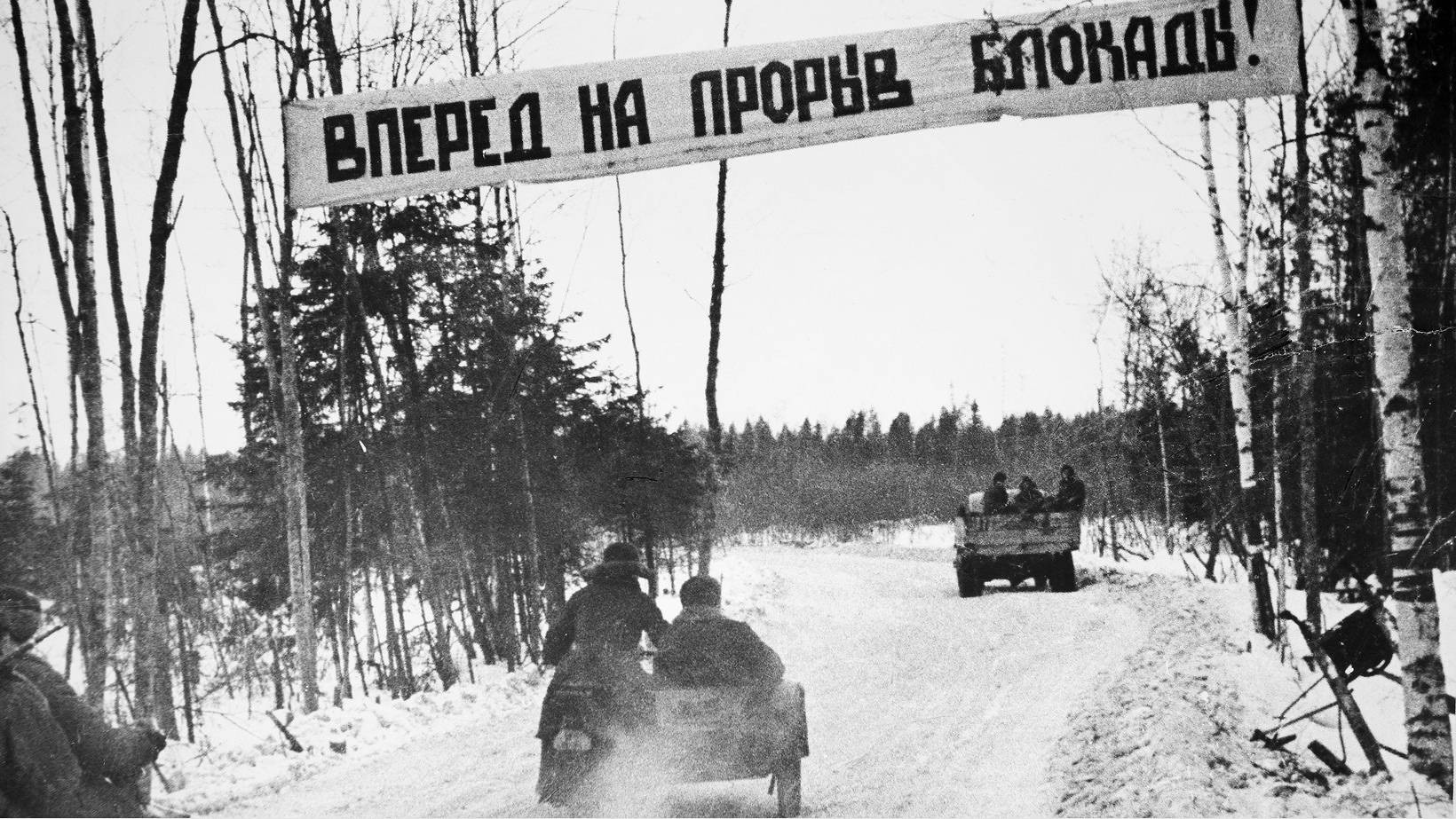 In the course of the continuation of Operation Iskra in February, the 67th Army and the 2nd Shock Army had to solve several tasks: to storm the German defense center in the area of the 1st, 2nd Gorodok and 8th GRES, capture the Sinyavinsky heights and in cooperation with the 55th and 54th armies, defeat the enemy’s Mginsko-Sinyavinskaya grouping.
In the course of the continuation of Operation Iskra in February, the 67th Army and the 2nd Shock Army had to solve several tasks: to storm the German defense center in the area of the 1st, 2nd Gorodok and 8th GRES, capture the Sinyavinsky heights and in cooperation with the 55th and 54th armies, defeat the enemy’s Mginsko-Sinyavinskaya grouping.
On February 17, after several days of heavy fighting, the 102nd, 138th and 142nd rifle brigades of the 67th Army, thanks to the effective support of artillery, managed to capture the 1st and 2nd Gorodoks and the 8th GRES, and by February 20 go to the northern outskirts of the village of Arbuzov. Thus, the land connection with the Nevsky “piglet” was restored and a small ledge in the front in this area was cut off. In total, units of the 67th Army managed to advance 5 kilometers, but due to significant losses, the further offensive was forced to stop.
At the end of January, formations of the 2nd Shock Army launched an offensive with the aim of capturing the Sinyavinsky Heights, striking in a south-westerly direction from the areas of Workers’ Settlement No. 7 and Gontovaya Lipka. The fighting immediately took on an extremely fierce character. So, within 10 days, units of the 2nd shock army with the forces of 35 battalions stormed the height of 43.3. At the same time, the 73rd Naval Rifle Brigade, the 80th and 364th Rifle Divisions, and then the 64th Guards Rifle Division, reinforced by a significant artillery group, stormed the height with a mark of 50.1. The heights changed hands several times, but in the end, units of the German 21st Infantry Division and the 540th Penal Battalion, supported by several Tiger tanks, managed to keep them in their hands. After several days of relative calm, on February 12-13, attacks by units of the 2nd shock army on the Sinyavin Heights resumed and continued until the end of February, but again they were not successful. Thus, the offensive of the 2nd shock army was not successful and was stopped. Moreover, on March 6, units of the German 212th Infantry Division, with the support of the 502nd Heavy Tank Battalion, carried out a local offensive operation and liquidated a penetration into their defenses between Sinyavino and Rabochesky Settlement No. 7. As a result, units of the 128th, 18th, and The 11th Soviet rifle divisions were surrounded and suffered heavy losses, and the front line shifted north of the Sinyavino-Gontovaya Lipka road.
The results of the February battles and new offensive plans
 In directive No. 30057 of February 27, the Headquarters of the Supreme Command stated that “the operations carried out on the Leningrad and Volkhov fronts did not produce the expected results,” and the inept actions of the 67th Army and the 2nd Shock Army led to “purposeless heavy casualties in manpower and equipment.” The troops of all four armies (54th, 55th, 67th and 2nd shock) were ordered to temporarily stop the offensive and gain a foothold on the occupied lines, and the commanders of the fronts to submit considerations for the next joint offensive operation by March 3.
In directive No. 30057 of February 27, the Headquarters of the Supreme Command stated that “the operations carried out on the Leningrad and Volkhov fronts did not produce the expected results,” and the inept actions of the 67th Army and the 2nd Shock Army led to “purposeless heavy casualties in manpower and equipment.” The troops of all four armies (54th, 55th, 67th and 2nd shock) were ordered to temporarily stop the offensive and gain a foothold on the occupied lines, and the commanders of the fronts to submit considerations for the next joint offensive operation by March 3.
Despite the fact that the offensive of the North-Western Front in February, as well as near Leningrad, did not achieve its goals, the Soviet command still expected to implement the Polar Star plan in March, but with more modest goals. According to the next plan of the Headquarters of the Supreme High Command, the North-Western Front went on a new offensive on March 4 in the direction of Staraya Russa, and the 55th Army of the Leningrad Front and the 8th Army of the Volkhov Front – on March 14, having received the same task – to surround and destroy the Mginsko-Sinyavinskaya enemy grouping. The bloodless 67th and 2nd shock armies were supposed to join the offensive only in case of success on the flanks.
The 8th Army was to break through the enemy defenses on the Voronovo-Lodva front and capture the Sologubovka-Muya area, cut off enemy communications and go to the rear of the enemy’s Mginsk-Sinyavin grouping. The 55th Army, advancing from the Krasny Bor -Peschanka area, was to develop the offensive in the direction of Ulyanivka and, after capturing Sablino, cut off the railway and highway communications in the Ulyanovka- Mga sector, followed by the development of an attack on Voitolovo, where it was supposed to unite the troops of the 8th Army and close the environment ring.
In early March 1943, due to the drastically changed situation on the southern front of the Soviet-German front, the Polar Star operation was actually canceled. The troops of the North-Western Front nevertheless launched an offensive on March 5. The troops of the Leningrad and Volkhov fronts failed to prepare for the offensive by March 14 and the start of the operation was postponed for 5 days. By this time, the troops of the North-Western Front, having not achieved success, were already completing the operation, which was finally terminated on March 17.
Continuation of the offensive, March 19 – April 2, 1943
On March 19, the 55th Army launched an offensive from the Krasny Bor area in the direction of Ulyanovka. At the beginning of the operation, the army troops managed to break through the front in a section of 6.5 kilometers and move forward up to 2.5 kilometers. Later, after fierce battles, the advanced units of the army advanced 8-10 kilometers and reached the northwestern outskirts of Sablino and Ulyanovka. Until the beginning of April, formations of the 55th Army repeatedly tried to resume the offensive, but they did not achieve success.
Simultaneously with the beginning of the offensive of the 55th Army, the 8th Army launched an offensive on Mga from the area south of Voronov. On the front from Gontovaya Lipka to the Pogostya area, Soviet troops were opposed by units of the 1st, 223rd, 69th Infantry and 285th Security Divisions.
After three days of fighting, the first echelon of the 8th Army (256th, 265th, 286th, 374th and 378th rifle divisions, supported by the 35th, 25th, 33rd and 50th tank regiments) broke through the German defenses in the Voronovo-Lodva section 8 kilometers wide and moved forward up to 2-5 kilometers. A mobile group consisting of a regiment of the 64th Guards Rifle Division and a tank battalion of the 122nd Tank Brigade managed to bypass the powerful Karbusel defense center from the north and cut the Mga- Kirishi railway east of the Turyshkino station. However, the command of the German 18th Armymanaged to transfer the 21st, 121st infantry divisions, 2 regiments of the 11th infantry division, which managed to stop the advance of the 8th army. The introduction of the 14th Rifle Division and the 1st Rifle Brigade into battle on April 1 to support the success of the 64th Division did not bring any result.
On April 2, the Headquarters of the Supreme High Command ordered the troops of the Leningrad and Volkhov fronts to stop the offensive and go on the defensive. Thus, the second attempt to encircle the Mginsko-Sinyavino grouping of the enemy ended in failure.
Aviation in Operation Iskra
Preparation
By the beginning of the operation, the troops of the Leningrad Front were supported by the 13th Air Army, the Air Force of the Red Banner Baltic Front, the 7th Air Defense Fighter Corps and mixed air regiments of the 42nd, 67th and 23rd armies. All these forces were under operational control of the commander of the 13th Air Army.
By the beginning of the operation, the 13th Air Army and the 7th Fighter Aviation Corps had 287 aircraft: 26 bombers, 40 attack aircraft, 171 fighters, the remaining 50 aircraft were reconnaissance aircraft, spotters, transport, communications. Basically, these were new types of aircraft – Pe-2 bombers, Il-2 attack aircraft, Yak-7, La-5 fighters.
The Air Force of the Baltic Fleet had 238 aircraft. The troops of the Volkhov Front were supported by the 14th Air Army, the 2nd Fighter Air Corps, and the 232nd Assault Air Division. These forces were operationally subordinate to the commander of the 14th Air Army. As part of this grouping, there were 374 serviceable aircraft. Thus, there were 899 aircraft in the composition of the two fronts and the fleet.
On the part of the Nazi troops in front of the Leningrad and Volkhov fronts, about 150 aircraft were based, allocated from the 1st Air Fleet, supporting the 18th German Army from the air. Enemy aviation was mainly reconnaissance of our troops, communications, in small groups they tried to bomb the transshipment bases on Lake Ladoga and Leningrad at night and did not show much activity.
In preparation for the operation, the pilots of the 13th Air Army carried out a thorough reconnaissance of the enemy’s defensive lines. The leading edge, airfields and communications were studied in particular detail. Reconnaissance and perspective-panoramic aerial photography of the enemy defenses was carried out by the 5th long-range reconnaissance squadron and specially assigned crews in the army air regiments. An area of 2015 km² was photographed. According to photographic reconnaissance, topographic maps with imprinted conditions were created. 196 photographic plates with decoded targets were made. They provided ground forces and aviation units.
To improve the interaction of aviation of the Leningrad, Volkhov fronts, the Air Force of the Baltic Fleet with the ground forces, an auxiliary command post was deployed by the commander of the 13th air army with the commander of the 67th army, which delivered the main blow in the Leningrad Front. Pilot officers with communications equipment were sent to the rifle divisions of the first echelon, whose task was to receive requests from the ground command for the destruction of enemy troops and facilities and transfer them to the command posts of aviation formations and units, as well as inform the aviation command about changes on the line of contact with the enemy.
Preparations for the operation were carried out by the aviation engineering service. The field aircraft repair workshops were fully staffed with personnel, tools and equipment. Each repair base and aircraft workshop prepared teams of specialists for the repair of aircraft in the field with the necessary stocks of materials and spare parts.
A lot of work was done by aviation logistics specialists. By the beginning of the operation, 375 shelters for aircraft were built at airfields, access roads and roads were repaired, old airfields were equipped and new ones were built, runways and taxiways were repaired. A network of false airfields was created, communication centers were equipped, dugouts, workshops, and canteens were built. Prior to the start of the operation, aviation logistics units brought in ammunition, the necessary aviation equipment, and fuel and lubricants.
Offensive
On January 12, 1943, the troops of the Leningrad and Volkhov fronts went on the offensive. The weather conditions at that time were very difficult for aviation operations. Cloudiness dropped below 100 m, horizontal visibility did not exceed 500 m. Difficult weather did not allow the use of aircraft in large groups. Support for ground units and the suppression of enemy mortar and artillery batteries was carried out by small groups of attack aircraft and fighters. When crossing the Neva, our fighters covered the advancing rifle units from German air strikes.
During the first day of the offensive, the pilots of the 13th Air Army made 159 sorties. On the Volkhov Front, before the start of artillery preparation, groups of bombers and attack aircraft of the 14th Air Army attacked enemy strongholds and firing positions. With the beginning of the offensive, units of the 14th Air Army carried out tasks similar to those performed by the Air Force of the Leningrad Front.
After the weather conditions improved, light night bombers Po-2 joined the combat work. On the night of January 14, 15 Po-2 aircraft made 44 sorties (29 for bombing and 15 for reconnaissance). Night attacks on the enemy were of great importance, because the Nazi command sought to prevent the connection of the Leningrad and Volkhov fronts and to hold the Schlisserburg ledge at any cost. On January 14 and 15, the 13th Air Army, taking advantage of the favorable weather, made 499 sorties.
German aviation also intensified its operations. Of the 416 enemy aircraft noted in the breakthrough zone in the second decade of January, 187 took part in air battles. It was especially difficult for our attack aircraft, which operated at the very front line at low altitudes.
After breaking the blockade of Leningrad, our troops had to gain a foothold in the liberated territory and expand the front of the breakthrough. At the end of January, the 1st bomber air corps was involved in the fighting on the Volkhov Front.
The fascist German command urgently understaffed the existing formations of the 1st Air Fleet – three groups of bombers were deployed near Leningrad. The number of aircraft in the Leningrad direction was increased to 250. The activity of enemy aircraft increased significantly. During the first decade of January, she made 215 sorties, in the second decade 311, and in the third 558. German aviation operated mainly against our troops on the battlefield and near rear.
Opposition to our air forces intensified, the fight in the air became more fierce. The fighting took on a protracted character.
During the whole of January, despite very difficult weather conditions, aviation units and formations of the 13th Air Army made 2426 sorties, of which 1636 during the day and 790 at night. 702 sorties were made by pilots of the 7th Fighter Air Corps. Up to 60% of the sorties of the 13th Air Army were carried out by crews to support troops on the battlefield. In January 1943, our pilots shot down 74 enemy aircraft in air battles, another 45 were destroyed by our anti-aircraft artillery.
During the offensive operations of our troops in February, the crews of the 13th Air Army, assisting the 55th and 67th armies, made 2027 sorties, suppressed the fire of 200 artillery and mortar batteries, destroyed a lot of enemy military equipment and manpower, carried out 48 air battles and shot down 37 enemy aircraft. At the beginning of the offensive during this period, the aviation of the 13th Air Army consisted of 310 aircraft.
When the troops of the 55th Army resumed the Krasnobor operation in March, the main efforts of the 13th Air Army were aimed at supporting the ground forces. Of the 2988 sorties, 2004 were made to destroy enemy manpower and equipment on the battlefield and in its rear, 241 for reconnaissance. Stubborn air battles continued throughout the month.
Operation results
On January 18, 1943, the troops of the Leningrad and Volkhov fronts broke through the blockade of Leningrad. Although the military success achieved was rather modest (the width of the corridor connecting the city with the country was only 8-11 kilometers), the political, material, economic and symbolic significance of breaking the blockade cannot be overestimated. In the shortest possible time, the Polyany-Shlisselburg railway line, the highway (after the war became part of the Murmansk highway, the modern P21 highway) and several bridges across the Neva were built. On February 7, the first train from the “mainland” arrived at the Finland Station. Since mid-February in Leningradfood supply norms established for other industrial centers of the country began to operate. All this radically improved the situation of the inhabitants of the city and the troops of the Leningrad Front.
Breaking the blockade was a turning point in the battle for Leningrad. Even the theoretical possibility of an assault on Leningrad by German troops was finally removed – the initiative in the North-West direction finally passed to the Soviet troops. In this situation, the Supreme Command Headquarters considered it possible not only to build on the success achieved and restore control over the Kirov Railway, but also to carry out an even larger-scale operation – to completely lift the blockade of Leningrad and liberate the entire Leningrad region. However, Operation Polaris ended in failure. Soviet troops near Leningrad failed to develop an offensive, defeat the German Mginsko-Sinyavinskaya grouping, ensure a strong railway connection between the city and the country, and also push the enemy back to a distance that excludes artillery shelling. It was only in January 1944 that Leningrad was fully liberated from the enemy blockade during the Leningrad-Novgorod operation.
Side losses
the USSR
The total losses of Soviet troops during Operation Iskra (January 12-30) amounted to 115,082 (33,940 – irretrievably), while the Leningrad Front lost 41,264 people (12,320 – irretrievably), and Volkhovsky – 73,818 people (21,620 – irrevocably). In addition, during this period, Soviet troops lost 41 tanks, 417 guns and mortars, and 41 aircraft. According to other sources, losses in military equipment were more significant. So, according to the historian I. B. Moshchansky, only the Leningrad Front lost 221 tanks, and the historian M. E. Morozov determines the losses of Soviet aviation in 181 aircraft. German studies indicate even more significant numbers (for the period January 12 – April 4): 847 tanks and 693 aircraft.
Since there are no official data on the losses of the Leningrad and Volkhov fronts in the February-April operations, the losses of the Soviet troops during this period can only be estimated approximately.
According to the historian G. A. Shigin, the total losses of Soviet troops during this period amounted to more than 150,000 people (losses of the 67th and 2nd shock armies in February – 55,000 – 57,000, losses of the 55th and 54th armies in February – 38,000 – 40,000, losses of the 8th and 55th armies in March – early April 57,000 – 58,000). These data are consistent with the estimate of losses given by the American historian D. Glantz – 150,000 (35,000 – irrevocably) and disagree with German estimates, according to which the losses of Soviet troops in January – early April amounted to 270,000 people.
Germany
Soviet sources most often indicated the following figures for German losses during Operation Iskra on January 12-30, 1943: 19,000 killed and wounded, 1,275 prisoners. The enemy lost 272 guns, 1200 machine guns, more than 300 mortars. Some sources repeat data close to the information from the report of the Soviet Information Bureau of January 18, 1943 – 13,000 people only killed and 1261 people captured, although it is obvious that these data, even if they are considered objective, refer only to the initial period of the operation. In addition, it is alleged that the losses of German troops in equipment during the first part of Operation Iskra alone amounted to 650 guns (400 of them were captured), 300 mortars, 500 machine guns, at least 100 aircraft.
According to German data (summary reports of the army headquarters on losses), in January 1943, the 18th Army lost 22,619 people. For the first half of the month, the total losses of the army (taking into account the losses of divisions that did not directly participate in the battle) amounted to 6406 people (of which 1543 were killed and missing), and in the period from January 16 to 31 – 16 213 people (of which 4569 – irrevocably). The greatest losses were suffered by the 1st (2342 soldiers and officers killed, missing and wounded), 61st (2706), 96th (3202), 170th (1679), 227th (2444) infantry and 28 1st Jaeger (1849) division. The total losses of these 6 divisions amounted to more than 75% of the total losses of the entire 18th Army in January. The 502nd heavy tank battalion, the only German tank unit that took part in the battle, also suffered significant losses. By the end of January, only two Pz.Kpfw.VI “Tiger” tanks and several PzKpfw III tanks remained in the battalion, all of which were damaged or out of order. The remaining tanks (more than 20) were lost forever, including 6 tanks Pz.Kpfw.VI “Tiger”.
Confirmation of the fact that fierce fighting near Leningrad continued in February 1943 is the loss rate of the 18th Army this month – 29,448 people (of which 9,632 were irretrievable losses). Particularly heavy losses were suffered by the 250th Spanish division (total losses – 2952) and the SS Police Division (2860), operating against units of the 55th army. The divisions holding the defense on the Sinyavin Heights also suffered heavy losses, in particular, the 21st (2669) and 11th (1922). In March, the losses of the 18th Army were also significant – 21,242 soldiers and officers (of which 3,867 were irretrievable losses).
Thus, the losses of the 18th Army in January-March 1943 amounted to 73,309 killed, wounded and missing (of which 19,611 people were irretrievably).
Operation Iskra in historiography
For a long time, in the official Russian (and before that, in the Soviet) historiography, only the military operations of the 67th, 2nd shock and 8th armies of the Leningrad and Volkhov fronts in the period from January 12 to January 30, 1943 were attributed to Operation Iskra. At the same time, only the initial and most successful period of the offensive was described most fully – until the moment the blockade was broken. Much less has been said about the course of hostilities since the second half of January, and although the February-April operations were not considered part of the Iskra operation, they were not named in any way.
For this reason, various interpretations of these events and various naming of operations near Leningrad in February-April appeared in the historical literature: Krasnoborskaya (offensive of the 55th Army of the Leningrad Front in the Krasny Bor region in February, and then in March-April), Smerdynskaya, Karbuselskaya (offensive of the Volkhov Front – 54th Army in February and 8th Army in March – April), Krasnoborsko-Smerdynskaya, Tosno-Mginskaya (joint offensive of two fronts 10 -February 27), Mginsko-Sinyavinskaya, Voitolovo-Mginskaya (joint offensive of two fronts March 19 – April 2) etc. However, the fact that even according to the original plan of the Headquarters of the Supreme High Command, the breakthrough of the blockade was only the first stage of the offensive, gave grounds to a number of historians to consider the military operations of the Soviet troops near Leningrad during this period as a continuation of Operation Iskra. At the same time, both in a number of publications of the Soviet period and in the works of modern historians, the joint operations of the Leningrad and Volkhov fronts in February – April are described as part of the general strategic offensive of Soviet troops in the northwestern direction codenamed “Polar Star”.
As a result, the interpretation of events in the official publications of the Ministry of Defense of the Russian Federation has also changed somewhat. Thus, in the third volume of the encyclopedia “The Great Patriotic War of 1941-1945” of the 2012 edition, the time frame for Operation Iskra was expanded. The entire operation is conditionally divided into three phases: the first – until January 20, the second – until January 30, the third – until the end of February. Operation Iskra, as before, includes only combat operations of the 2nd shock, 8th and 67th armies, but now in January and February 1943. At the same time, operations to encircle the Mginsko-Sinyavinskaya enemy group February and March-April are considered separate operations (the first is designated as “Tosnensko-Mginskaya”, the second is not named in any way), which were an integral part of the strategic plan “Polar Star”.
In German historical literature, the fighting near Leningrad in January-April 1943 is usually referred to as the “Second Battle of Lake Ladoga” (or the “Second Battle of Ladoga”), which consisted of three stages: the main attack on January 12 – February 3, the offensive on the flanks with the aim of encirclement on February 10-24 and a second offensive on the flanks with the aim of encirclement on March 19 – April 4, 1943.




